
SABENA World Airlines
BELGIUM - OO
ICAO CODE: SAB
Callsign: Sabena
1920s
SABENA (Societe Autonyme Belge d'Exploitation de la Navigation Aerienne) began on 23 May 1923 as the Belgian national carrier. It took over from Belgium's previous airline, SNETA (Syndicat Aeriens pour l'Etude des Transports Aeriens) which was formed in 1919 as a national airline.
SABENA AIR LINES' first paying flight was on 1 April 1924 on a flight from Rotterdam to Strasbourg stopping at Brussels. Regular flights to Amsterdam and Basle via Strasbourg were started by 1923 with further routes to London, Bremen and Copenhagen by 1924.
When SABENA was formed it was part funded by Belgians in the Congo colony who had only a year before lost their air service - an experimental passenger and cargo company (L.A.R.A.) between Kinshasha, Lisala and Stanleyville - and expected the new Belgian national airline to fill this gap. So from 1925 SABENA pioneered a route to Africa and to Belgium's interests in the Belgian Congo.
SABENA chose to use landplanes for the Congo operation and a program of aerodrome building in the Congo began. These were finished in 1926 and SABENA immediately began flights within the Congo in line with it's mandate, the main route being Boma-Leopoldville-Elisabethville - a 1422 mile route over dense jungle. First flights were with De Havilland d.h. 50 aircraft although these were replaced with the larger H.P. W8f airliners which had three engines and ten seats.
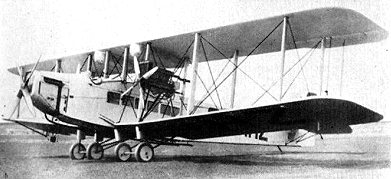
During the early stages the airline used the Farman Goliath, the Breguet 14 and various British-built Handley-Page aircraft including the Handley-Page W8f.
1930s
By 1931 SABENA's fleet, including the aircraft used on the Congo network, totalled 43 aircraft. It's mainstay type was the Fokker 7b with a lesser number of the smaller Fokker 7a and 14 Handley-Page types. It also used the British Westland Wessex aircraft.
SABENA flew aircraft out to Tropical Africa - it's Congo colony - occasionally but mostly these aircraft were shipped out. The flight from Belgium to the Congo had, in the past taken 51 days... a mammoth flight. But as the 1930s progressed SABENA cooperated with Air France and Deutche Luft Hansa on over-flight rights (who also had interests in routes over Africa and the Congo) and began it's first regular scheduled service from Brussels to Leopoldville in the Congo.
Thus, SABENA's first long-haul flight to the Congo occurred 23 February 1935 and took five and a half days. It was flown by a SABENA Fokker F7b on a direct service. The following year SABENA purchased the latest airliner, the Savoia-Marchetti S.M. 73. At a speed of 200mph it reduced this route to only four days and the service ran alternative weeks in cooperation with Air Afrique who flew the every other week.
In Europe SABENA opened services to Copenhagen and Malmo in 1931. A route to Berlin began in 1932. The mainstay pre-war airliner that SABENA used in Europe was the successful Junkers Ju-52/3m airliner. The airline's pre-war routes covered almost 6000 kms within Europe alone.
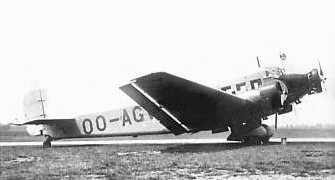
From 1936 SABENA was using the pride of European airlines, the fast and comfortable Italian Savoia-Marchetti S.M.73 tri-engined airliner which was used mainly on the Congo route (SEE POSTER BELOW). SABENA purchased a fleet of eleven of this type.
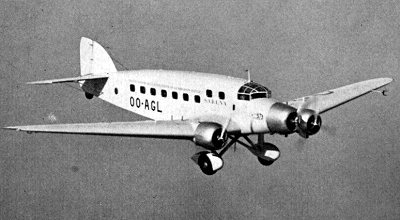
In 1938 the airline purchased the new S.M. 83, a development of the S.M. 73 with a speed of 270mph although it flew services at about 250mph. During World War Two the airline managed to maintain it's Belgian Congo routes.
By the outbreak of war in Europe in 1939 SABENA's fleet totalled 18 aircraft. It's mainstay fleet type was the Savoia-Marchetti SM-73 airliner (it had 11 of the type) and the Junkers Ju-52/3m airliner (it had 5). SABENA also had two Douglas DC-2s.
1940 & 1950
WORLD WAR TWO stopped all European services.
After the second world war in 1946 SABENA's fleet consisted of Douglas DC-3s. (There were tens of thousands of C-47 Dakotas available to help airlines restart operations after the war). The airline now flew under the name SABENA - Belgian World Airlines.
4 June 1947 saw SABENA start a new route across the Atlantic to New York initially using Douglas DC-4s which were quickly replaced by Douglas DC-6Bs. These 'fours' and 'six-Bs' also restarted the airline's historic route to the Belgian Congo. The SABENA markings for the immediate post-war period up to the early 1950s are shown on the Douglas 'Super DC-6B' shown here...

Other equipment used included DH Dove twins and various helicopters.
Convair 240s were purchased and introduced in 1950 to replace the DC-3 twins, which had flown all European services.
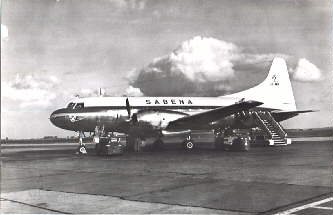
Convair 440 'Metropolitan' twins replaced the earlier Convair 240 twins and were used successfully well into the 1960s across European regional destinations.
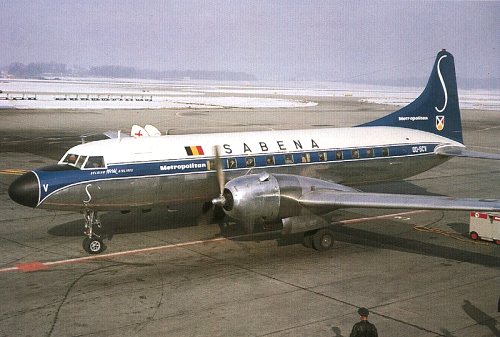
In 1957 the long-haul Douglas DC-7C - the 'Seven Seas' was introduced for long-haul routes but would be supplanted after only three years by the jet age.
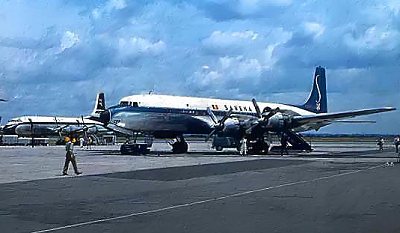
1960s
1960 saw big changes for SABENA when the state of Zaire was founded ending the long-held route from Belgium to the Congo. 1960 also saw the introduction of the new Boeing 707-320 intercontinental jet for it's long-haul trans-Atlantic flights to New York. SABENA was mainland Europe's first airline to operate a jet across the Atlantic (BOAC had been flying trans-Atlantic Comet 4 jet services before 1960).
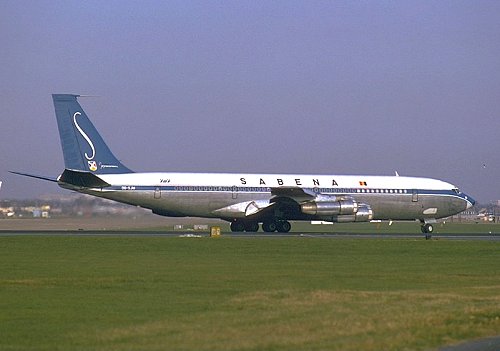
Sud-Est SE-210 Caravelle 6 jetliners were introduced on all medium-haul routes in Europe from February 1961 and were flown on most European routes, alongside the Convair 440s, until the early 1970s.
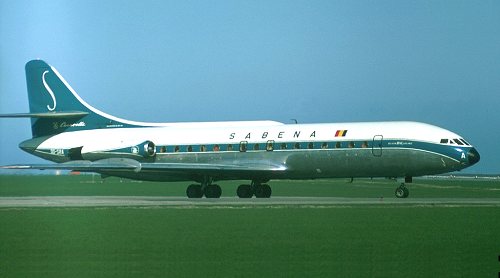
1961 also saw a major upheaval for SABENA in the Congo colony. When the old Belgian Congo became the Republic of Congo belgians fled, transported by SABENA. This was the end of the impressive regional network of routes and airports in Congo that the airline had built up since 1924. When the new Republic began it's own airline: Air Congo, in June 1961 SABENA held 30 percent of that airline's shares.
Douglas 'Super DC-6B' aircraft were still in use with SABENA in the mid 1960s despite the airline introducing a fleet of modern Boeing 707 jets. These aircraft were no longer used on SABENA's main schedules though - the Boeing 707s and Caravelles were the mainstay types during this decade.
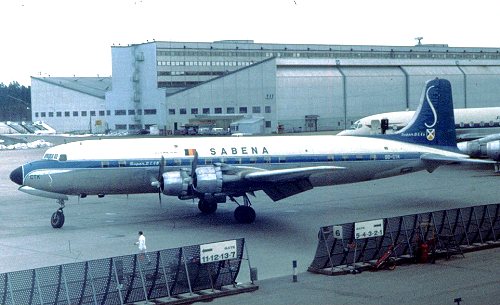
Boeing 727-100s were introduced important European routes from 1967 and the jet was introduced in a colour scheme of it's own, the fin markings incorporated bare-metal rudder and white engine colours. The only other aircraft to have it's own special markings was the Douglas DC-10.
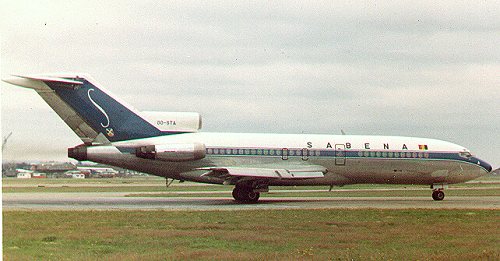
Fokker F-27 'Friendships' were also introduced at this time and they were used from regional Belgian airports to European destinations such as Heathrow.
1971 saw Boeing 747-200s introduced on the transatlantic routes flying alongside the Boeing 707-320Cs. SABENA, like many other trans-Atlantic airlines was happy with the Boeing 707s but for commercial reasons it had to buy the new jumbo-jets for it's prestige services like New York. SABENA purchased only two and continued to fly the 707 into the late 1970s.
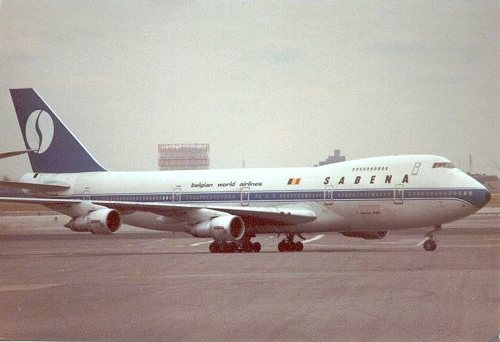
1973 saw Boeing 737-200s replacing the Boeing 727s on the European services.
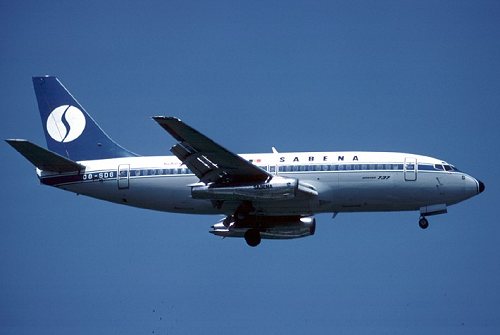
Douglas DC10-30CFs were introduced from 1974 and SABENA purchased four of these convertible wide-body jets.
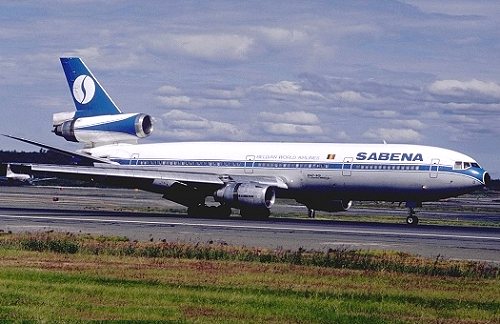
In 1984 Airbus A310s were introduced on routes that had high passenger-density. This aircraft type also introduced a modernisation of the 1973 SABENA colours in which a lighter blue was used and the titles on the fuselage were in modern style.
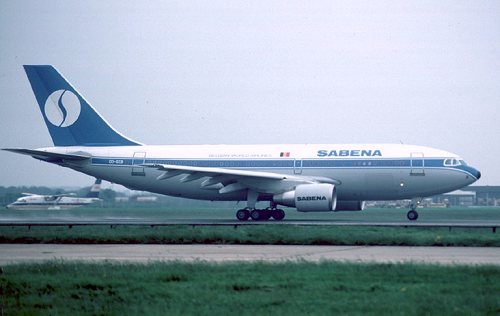
1990 - SABENA WORLD AIRLINES
A new name - SABENA World Airlines - and livery was introduced for the 1990s.
The new colours had an overall white colour and the white circle tail logo in blue on the fin. A large 'sabena' title covered the fuselage in very light blue and at times was barely visible although the title was also painted on the fuselage in small clear letters. The 1990s saw further fleet type renewal - the DC-10-30s were replaced with MD-11 jets.
McDonnell-Douglas MD-11 McDonnell-Douglas MD-11 OO-CTG with CityBird titles - Marc Schaeffer1993 saw Air France purchase a large minority stake in SABENA which they sold soon after. In 1995 Swissair purchased a 49 percent stake in SABENA - a move which would bring the airline down in 2001.
And the Boeing 747-200s that had seen service since the 1970s were replaced with the new Airbus A340 long-haul jet. By the late 1990s the airline colours were changed again.
Airbus A340 OO-SCZ in new colours Airbus A340 OO-SCZ in new colours - 2001 - Carlos Borda1999 saw the new colours on the latest Airbus equipment to be used by SABENA - the Airbus A321.
Airbus A321 Airbus A321 on a pre-delivery flight - Airbus IndustrieOne of the latest fleet types that SABENA has introduced is the Airbus A-319 which saw service in 2000.
Airbus A319 Airbus A319 OO-SSA at Manchester in 2000 - Andy KennaughREGIONAL SERVICES
Delta Air Transport (DAT) fly many regional and domestic sheduled routes with a small fleet of Avro 100 feeder-liner jets in full Sabena livery but with small 'DAT' titles on the nose of the aircraft.
Avro RJ-85 OO-DWD Delta Air Transport Avro RJ-100 OO-DWD (owned by D.A.T.) in Sabena special livery - Marc SchaefferHELICOPTER SERVICES
SABENA operated helicopter services from 21 August 1950 when it used Bell 47D aircraft on an experimental postal service between Brussels and extending domestically to cities like Antwerp, Liege and Turnhout. It was begun in co-operation with the Belgian Post Office.
The Bell 47s were replaced with the larger Sikorsky S.55 allowing the service to extend to internationally to Maastricht. This was the world's first international helicopter service.
SABENA intended using helicopters on an international rotary-wing passenger service as a feeder service for it's fixed-wing international/European services. This was started on 1 September 1953 using the Sikorsky S.55 aircraft, which could carry eight passengers.
SABENA flew international services with Sikorsky S.55 SABENA began international passenger services with the Sikorsky S.55By October 1956 the service had new helicopters, the twelve-seat Sikorsky S.58 and SABENA's fleet of eight S.58 helicopters inauguated the service to Paris in 1957!
Sikorsky S.58 SABENA improved the helicopter services with eight Sikorsky S.58sBy 1960 this international passenger helicopter service from Brussels flew to Rotterdam, Antwerp, Lille, Eindhoven, Maastricht, Liege, Paris, Dortmund, Duisburg, Cologne and Bonn. It served Holland, France, Germany and Luxembourg internationally.
A HISTORIC AIRLINE IS GONE
After an airline recession and the effects on the airline industry of the terrorist attacks on America on 11th September 2001 all airlines that flew across the Atlantic suffered badly.
Further to this SABENA was owed 84 million by the Swiss airline Swissair. After Swissair stopped operations on 2nd October 2001 and refused to repay the money SABENA was forced to stop flying. They filed for legal protection against their creditors on 3rd October.
This gave SABENA about three weeks to get further financial backing. With most of the main airlines in Europe fighting for passengers in the aftermath of the attack on the USA and on civil aviation SABENA failed to gain the required backing and went into liquidation on 7 November 2001.
FLEET: Airbus A340, A321, Boeing 747-300, Boeing 737-200, 737-300, 737-400, 737-500, and Dash-8 turboprops. DAT use Avro 85 and Avro 100 jets. Airbus A330s were on order.
DESTINATIONS: 27 destinations in Africa, also Far East, Europe, and USA.